
Frogger is a 1981 arcade action game developed by Konami and manufactured by Sega. In North America, it was released by Sega/Gremlin. The object of the game is to direct a series of frogs to their homes by crossing a busy road and a hazardous river.

Berzerk is a multidirectional shooter designed by Alan McNeil and released for arcades in 1980 by Stern Electronics of Chicago. Following Taito's Stratovox, it is one of the first arcade video games with speech synthesis. Berzerk places the player in a series of top-down, maze-like rooms containing armed robots. Home ports were published for the Atari 2600, Atari 5200, and Vectrex.
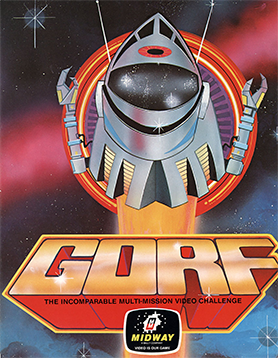
Gorf is an arcade video game released in 1981 by Midway Manufacturing, whose name was advertised as an acronym for "Galactic Orbiting Robot Force". It is a fixed shooter with five distinct levels, the first of which is based on Space Invaders and another on Galaxian. The game makes heavy use of synthesized speech for the Gorfian robot which teases the player, powered by the Votrax speech chip. Gorf allows the player to buy 2 additional lives per quarter before starting the game, for a maximum of 7 lives.
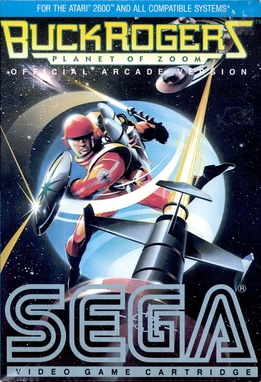
Buck Rogers: Planet of Zoom, known as Zoom 909 in Japan, is a pseudo-3D rail shooter released as an arcade video game by Sega in 1982. The player controls a spaceship in a third-person perspective, adapting the three-dimensional perspective of Sega's earlier racing game Turbo (1981) for the space shoot 'em up genre. It used the Buck Rogers license, referencing the space battles, though Buck himself is never seen.
The James Bond video game franchise is a series centering on Ian Fleming's fictional British MI6 agent, James Bond. Games of the series have been predominantly shooter games, with some games of other genres including role-playing and adventure games. Several games are based upon the James Bond films and developed and published by a variety of companies, The intellectual property is owned by Danjaq.

H.E.R.O. is a video game written by John Van Ryzin and published by Activision for the Atari 2600 in March 1984. It was ported to the Apple II, Atari 5200, Atari 8-bit family, ColecoVision, Commodore 64, MSX, and ZX Spectrum. The player uses a helicopter backpack and other tools to rescue victims trapped deep in a mine. The mine is made up of multiple screens using a flip screen style.

Montezuma's Revenge is a 1984 platform game for Atari 8-bit family, Atari 2600, Atari 5200, Apple II, ColecoVision, Commodore 64, IBM PC, and ZX Spectrum. It was designed and programmed by Robert Jaeger and published by Parker Brothers. The game's title references a colloquial expression for diarrhea contracted while visiting Mexico.
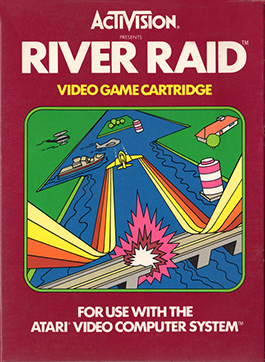
River Raid is a vertically scrolling shooter designed and programmed by Carol Shaw and published by Activision in 1982 for the Atari 2600 video game console. Over a million game cartridges were sold. Activision later ported the title to the Atari 5200, ColecoVision, and Intellivision consoles, as well as to the Commodore 64, IBM PCjr, MSX, ZX Spectrum, and Atari 8-bit family. Shaw did the Atari 8-bit and Atari 5200 ports herself.
In the history of video games, the second generation era refers to computer and video games, video game consoles, and handheld video game consoles available from 1976 to 1982 Notable platforms of the second generation include the Fairchild Channel F, Atari 2600, Intellivision, Odyssey 2, and ColecoVision. The generation began in November 1976 with the release of the Fairchild Channel F. This was followed by the Atari 2600 in 1977, Magnavox Odyssey² in 1978, Intellivision in 1980 and then the Emerson Arcadia 2001, ColecoVision, Atari 5200, and Vectrex, all in 1982. By the end of the era, there were over 15 different consoles. It coincided with, and was partly fuelled by, the golden age of arcade video games. This peak era of popularity and innovation for the medium resulted in many games for second generation home consoles being ports of arcade games. Space Invaders, the first "killer app" arcade game to be ported, was released in 1980 for the Atari 2600, though earlier Atari-published arcade games were ported to the 2600 previously. Coleco packaged Nintendo's Donkey Kong with the ColecoVision when it was released in August 1982.

Beamrider is a fixed shooter written for the Intellivision by David Rolfe and published by Activision in 1983. The game was ported to the Atari 2600, Atari 5200, Atari 8-bit family, ColecoVision, Commodore 64, ZX Spectrum, and MSX.

Frogger II: ThreeeDeep! is a video game released in 1984 by Parker Brothers for the Apple II, Atari 8-bit family, Atari 2600, Atari 5200, ColecoVision, Commodore 64 and IBM PC. It is a sequel to the 1981 Konami Frogger arcade video game and has similar gameplay.

Tutankham is a 1982 arcade video game developed and released by Konami and released by Stern in North America. Named after the Egyptian pharaoh Tutankhamun, the game combines a maze shoot 'em up with light puzzle-solving elements. It debuted at the European ATE and IMA amusement shows in January 1982, before releasing worldwide in Summer 1982. The game was a critical and commercial success and was ported to home systems by Parker Brothers.
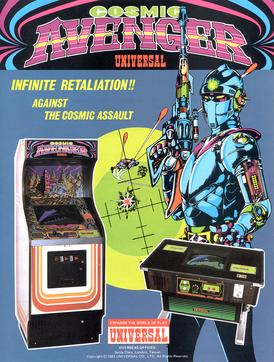
Cosmic Avenger is a horizontally scrolling shooter developed by Universal Entertainment Corporation and released in arcades by Universal in July 1981. It is one of the first shooters with forced X-axis scrolling along with Konami's Scramble released earlier in the year. The final installment in Universal's Cosmic series, players take control of the Avenger space fighter and use bullets and bombs against enemy forces.

The Dukes of Hazzard is a 1984 racing video game developed and published by Coleco for their ColecoVision game console and Coleco Adam computer. Elite Systems released a different game with the same title for the ZX Spectrum computer on February 23, 1985. Both versions are based on the television series of the same name.
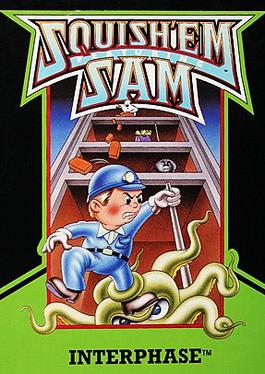
Squish'em, also known as Squish'em Sam, is a 1983 video game designed by Tony Ngo and published by Sirius Software for the Atari 8-bit family, VIC-20, Commodore 64, MSX, and the ColecoVision console. The ColecoVision version features digitised speech without additional hardware and was published as Squish'em Featuring Sam. The game is the sequel to Sewer Sam.

Dishaster is an action game released for the Atari 2600 in 1983 by Zimag. Another version of the game was released by Bit Corporation under the name Dancing Plates which features oriental-themed graphics and adds eight game variations.
Laura Nikolich is a game designer and programmer who worked for Parker Brothers in the early 1980s where she was the sole developer for the 1982 Atari 2600 game Spider-Man and programmed the ColecoVision version of Frogger II: ThreeeDeep!.

Threshold is a space-themed fixed shooter written by Warren Schwader and Ken Williams for the Apple II and published by On-Line Systems in 1981. Inspired by Sega's Astro Blaster arcade video game, Threshold introduces many enemy ship types and wave formations as the game progresses. Reviewers found the variety distinguished the game from the many similar shoot 'em ups.

Looping is an action game developed and published in arcades in 1982 by Video Games GmbH in Europe and Venture Line in North America. The player controls a plane across two phases in order to reach a docking station by destroying a terminal base or a rocket base to open a gate while avoiding obstacles along the way.

















